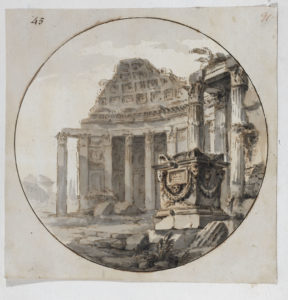
THE ADAM BROTHERS
The Scottish brothers Robert (1728–92) and James Adam (1732–94) defined the British architectural style of the late 18th century. The success of their innovative brand of Neoclassicism rested upon the free and inventive way in which they adapted the architecture of the classical past, reshaping it in a light and elegant manner that appealed to modern tastes. The new decorative style they forged in country and town-house commissions such as Syon House, Kedleston Hall and Osterley Park in the 1760s and 70s put them at the forefront of dynamic changes taking place in European architecture. And their influence was widespread, the Adams being among the few British architects whose work made an impact abroad, not only in Europe but also in Russia and North America.
THE ADAMS’ GRAND TOUR
In October 1754, at the age of 26, Robert Adam left Dover on the first leg of a Grand Tour. His prime destination was Rome, where he resided from February 1755 until May 1757. Rome was at the time the artistic capital of Europe, flooded with visiting architects, artists, dealers, connoisseurs and collectors, whose antiquarian interests and activities helped define the emerging Neoclassical style. The experience transformed Adam from a talented Scottish architect into a designer of international significance. His younger brother and architectural partner James followed his example and undertook his own Grand Tour in 1760–3.
The letters, diaries and journals written by Robert and James Adam at this time form an extraordinary resource. They offer first-hand information not only on the activities and aspirations of the brothers at the start of their independent careers, but also on the culture of the Grand Tour, on the difficulties of travelling and the practicalities of trading in antiquities in mainland Europe, and on the artistic melting-pot that was Rome in the mid-18th century.
These documents are known from John Fleming’s seminal study of the Adam brothers’ early careers and family background, Robert Adam and His Circle in Edinburgh and Rome (1962), written shortly after their discovery. Naturally, given the book’s format, Fleming had to be selective in his use of material from the letters and chose to emphasize the social aspects of the Adams’ activities, so that the bulk of the collection and many important facets of the brothers’ Italian tours remain to be investigated and understood.
Replete with references to the leading artists and theorists whom they encountered – such as Clérisseau, Piranesi, Winckelmann, Mengs, Cavaceppi, Gavin Hamilton and Allan Ramsay – the Adams’ Grand Tour correspondence constitutes one of the last great collections of unpublished 18th-century letters, capturing a seminal moment of transformation in Western art and architecture.
